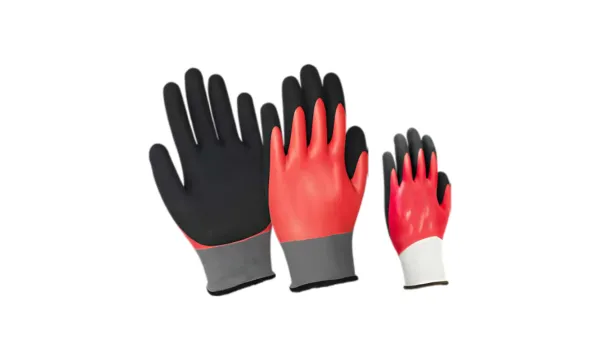When it comes to workplace safety, protecting your hands is as important as protecting your head and other body parts. In doing everyday tasks, your hands are most vulnerable to injuries like cuts and burns as they get exposed to chemicals and sharp objects. You can get small cuts to serious injuries from electrical shocks; this makes it crucial to wear safety gloves to safeguard your hands from potential hazards.
In this blog, we will discuss the importance of safety gloves, types of safety gloves, and how to choose the right gloves for your needs.
Why Are Safety Gloves Important?
Safety gloves are more than just an accessory; they are protective gear. Here are some of the reasons why safety gloves are important:
Preventing Injuries
If you’re working in industries including manufacturing, construction, mechanical, woodworking, etc., your hands are vulnerable to injuries like cuts, punctures, and abrasions. Safety gloves are made using special materials like latex, nitrile, leather, etc., creating a safety barrier to minimize the risk of injuries.
Shielding Against Chemicals
In the industries where hazardous substances and chemicals are used, the use of safety gloves is mandatory, as it can protect your hands from irritation, burns, or other harmful chemicals.
Heat And Electricity Insulation
In high-temperature environments and electrical work, specialized gloves help to prevent severe burns or shocks.
Enhanced Productivity
Injuries can reduce efficiency at work and increase downtime. Wearing protective gloves can help you maintain a safe and productive work environment.
Compliance With Safety Standards
In most industries, it is mandatory to wear safety gloves to comply with health and safety regulations, ensuring workers’ well-being.
Types Of Safety Gloves And Their Uses
Choosing the right type of safety gloves is important from the aspect of safety and efficiency at the workplace. Each type of glove is tailored to cater to a specific task or industry. Here are some of the common types of safety gloves and their applications:
Knitted Gloves
Knitted gloves are versatile and have use cases in diverse industries, including construction, automotive, packaging, and general maintenance. They provide protection against dirt, abrasions, and minor injuries. The knitted design makes them breathable and comfortable to wear for a long time. To enhance your grip and durability, some of the knitted gloves can be made with materials like latex or nitrile.
Disposable Gloves
Disposable gloves are designed for single-use applications and are popularly used in the healthcare, food processing, and laboratory environments. They offer protection against contaminants, chemicals, and pathogens, which makes them essential for maintaining hygiene. These gloves are commonly made from nitrile, latex, or vinyl to offer resistance against chemicals.
Industrial Leather Gloves
Industrial leather gloves are known for their durability and resistance to abrasion, thus are ideal for heavy-duty tasks. They are commonly used in construction, welding, and mechanical work, where protection from sharp edges, heat, and heavy materials is required. Leather gloves also provide a good grip, making them suitable for handling tools and machinery.
Coated Gloves
Coated gloves are of different types based on the layer they are coated with, including nitrile gloves, latex gloves, and PVC gloves. Cotton or polyester is used as the base material for such types of gloves, and then they are coated with nitrile, latex, or PVC to enhance grip, provide puncture resistance, and provide protection against chemicals. These gloves are widely used in industries such as automotive, manufacturing, and warehousing, where both dexterity and protection are needed.
Heat-Resistant Gloves
Designed to withstand high temperatures, heat-resistant gloves are essential for workers handling hot materials or working in environments like foundries and kitchens. These gloves are made from specialized materials such as Kevlar or aluminized fabrics, providing protection against burns and thermal hazards while maintaining flexibility for precise tasks.
Each type of safety glove serves a unique purpose, ensuring that workers remain safe and productive in their respective roles. Selecting the right gloves based on the nature of the work and associated risks is crucial to maintaining workplace safety standards.
How To Choose The Right Types Of Safety Gloves
Specialized gloves are designed based on the type of task and industry you’re involved in. Choosing the right task is important to ensure safety and optimal performance. Here is a step-by-step guide to help you choose the right type of safety gloves:
- While choosing the gloves, it is important to consider the material suitable for the task, such as Kevlar, which is suitable for working with sharp tools, and nitrile for chemicals.
- Assess the risk of hazards that you’re likely to experience at your workplace.
- Check the size of gloves for comfort and fit, as ill-fitting gloves can reduce dexterity and efficiency.
- Choose high-quality gloves that meet the industry standards like EN 388 for mechanical tasks and EN 407 for thermal hazards.
- Always choose durable gloves that can withstand wear and tear so you can use them for a longer run.
Why JCBL Hand Tools Safety Gloves Are The Best Choice?
When it comes to safety equipment, JCBL Hand Tools safety gloves stand out for their durability and quality. Here are some of the reasons why JCBL Hand Tools is the best choice:
- Our gloves are designed with high-grade materials to ensure your safety.
- We use ergonomic design so it fits perfectly to offer comfort and dexterity.
- We offer a diverse range of gloves, ranging from cut resistance and chemical resistance to general-purpose gloves.
- Each pair of JCBL gloves meets or exceeds the safety standards.
Apart from safety gloves, JCBL Hand Tools offers high-quality safety equipment to ensure your overall safety at the workplace.
Maintenance Tips For Safety Gloves
To get the most out of your safety gloves, follow these maintenance tips:
- Regular Cleaning: Wash gloves according to the manufacturer’s instructions to remove dirt, oils, and contaminants.
- Proper Storage: Store gloves in a cool, dry place away from direct sunlight and chemicals.
- Inspect for Damage: Before use, check for tears, punctures, or signs of wear. Replace damaged gloves immediately.
- Avoid Misuse: Use gloves for their intended purpose only to maintain their effectiveness.
- Replace When Necessary: Even the best gloves have a lifespan. Replace them periodically for continued protection.
Also Read: How Many Types Of Safety Helmets Are There?
Conclusion
Safety gloves are a non-negotiable part of workplace safety, offering protection, comfort, and peace of mind. By understanding the types of safety gloves and their applications, you can make informed decisions to keep your hands safe. JCBL Hand Tools Safety Gloves provide top-tier protection, ensuring your safety in every task.
Invest in the right gloves today and experience the perfect blend of quality and safety with JCBL Hand Tools. Visit our website to check our complete range of hand tools.
FAQs
How often should I replace my safety gloves?
Replace gloves as soon as they show signs of wear or damage. Regular replacement ensures consistent protection.
Can I use the same gloves for multiple tasks?
It’s best to use gloves specifically designed for each task to ensure optimal safety and efficiency.
How do I know if a glove is chemical-resistant?
Check the manufacturer’s specifications for the glove’s chemical resistance properties and certifications.








